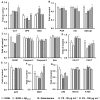Isolation of Fucoxanthin from Sargassum oligocystum Montagne, 1845 Seaweed in Vietnam and Its Neuroprotective Activity
- PMID: 37626806
- PMCID: PMC10452663
- DOI: 10.3390/biomedicines11082310
Isolation of Fucoxanthin from Sargassum oligocystum Montagne, 1845 Seaweed in Vietnam and Its Neuroprotective Activity
Abstract
Fucoxanthin extracted and purified from Vietnamese Sargassum oligocystum Montagne, 1845 exhibits various biological activities. In this study, the ability of fucoxanthin to inhibit acetylcholinesterase (AChE), the antioxidant activities, and the expression of antioxidant enzymes were investigated. Fucoxanthin isolated from Vietnamese S. oligocystum showed no cytotoxic effects; moreover, it exhibited AChE inhibitory activity (with an IC50 value of 130.12 ± 6.65 μg mL-1) and antioxidant activity (with an IC50 value of 3.42 ± 0.15 mg mL-1). At concentrations of 50 and 100 µg mL-1, fucoxanthin provided protection against amyloid β-protein fragment 25-35-induced neurotoxicity in a C6 neuronal cell line, and the survival of C6 cells was higher than 81.01% and 80.98%, respectively, compared to the control group (59%). Moreover, antioxidant enzyme activity and quantitative PCR analysis suggested that the neuroprotective effect of fucoxanthin resulted from regulation of the gene expression of antioxidant enzymes (CAT and GPx) and ER pathways (caspase-3 and Bax), as well as the promotion of expression of genes involved in PI3K/Akt signaling (GSK-3β), autophagy (p62 and ATG5), and the biosynthesis of ACh (VAChT and ChAT). Therefore, fucoxanthin extracted from the seaweed S. oligocystum in Vietnam is a potential feedstock source for the production of health foods that exert neuroprotective effects.
Keywords: Alzheimer’s; Sargassum oligocystum; acetylcholinesterase inhibitory; fucoxanthin; health food for humans; β-amyloid protein fragment.
Conflict of interest statement
The authors declare no competing interest.
Figures






References
-
- Ranga Rao A., Ravishankar G.A. Sustainable Global Resources of Seaweeds Volume 1: Bioresources, Cultivation, Trade and Multifarious Applications. Springer Nature; Cham, Switzerland: 2022.
-
- FAO . The State of World Fisheries and Aquaculture 2020. Sustainability in Action. FAO; Rome, Italy: 2020.
-
- Chopin T., Tacon A.G.J. Importance of seaweeds and extractive species in global aquaculture production. Rev. Fish. Sci. Aquac. 2021;29:139–148. doi: 10.1080/23308249.2020.1810626. - DOI
-
- Alghazwi M., Kan Y.Q., Zhang W., Gai W.P., Garson M.J., Smid S. Neuroprotective activities of natural products from marine macroalgae during 1999–2015. J. Appl. Phycol. 2016;28:3599–3616. doi: 10.1007/s10811-016-0908-2. - DOI
-
- Zhang L., Liao W., Huang Y., Wen Y., Chu Y., Zhao C. Global seaweed farming and processing in the past 20 years. Food Prod. Process. Nutr. 2022;4:28. doi: 10.1186/s43014-022-00113-0. - DOI
Grants and funding
LinkOut - more resources
Full Text Sources
Research Materials
Miscellaneous

